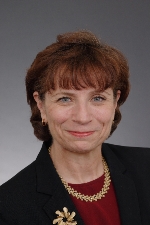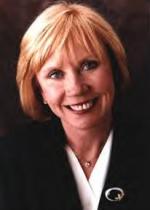
Time for Nurses to Claim Greater Leadership Roles, Experts Say
Nurses represent healthcare’s largest profession with about 3 million members in the United States, yet hospitals and health systems rarely tap them to serve as board members or in other leadership positions, leading to a lost opportunity for those organizations.

Susan Hassmiller, PhD, RN, FAAN, called it imperative that nurses serve on boards.
“I call nurses the reality check on boards,” said Susan Hassmiller, PhD, RN, FAAN, senior adviser for nursing at the Robert Wood Johnson Foundation (RWJF) and director of the Future of Nursing: Campaign for Action. “It’s detrimental to the quality of patient care in our country to not have nurses on the board.
While hospital board diversity is critical, Hassmiller added, if an organization does not have a nurse on the board--someone who really understands healthcare delivery from the ground up and can say whether something will or will not work--it can adversely affect that organization’s success. Nurses also can discuss quality measures and ways to avoid penalties for poor outcomes.
“It’s imperative nurses serve on boards,” Hassmiller said. At a minimum, the chief nursing officer should be invited to board meetings. People should not assume physicians can speak for all health professions.
Healthcare’s evolution opens opportunities to nurses seeking to serve in an executive leadership capacity, and more resources are becoming available to provide them with the additional skills needed to succeed in those roles.
“We take for granted our skills, our problem-solving abilities, and our ability to work in hideous complex settings, under enormous stress, and save lives,” said Connie Curran, EdD, RN, FAAN, co-author of the new book Claiming the Corner Office: Executive Leadership Lessons for Nurses and CEO of Best on Board, a healthcare governance education, testing and certification program based in Illinois. “It’s important those skills and perspectives move up the ladder to the C-suite, to the CEO and to boards.”

Connie Curran, RN, EdD, FAAN, co-wrote the book Claiming the Corner Office: Executive Leadership Lessons for Nurses, which can serve as a tool for nurses to move up.
Curran estimates only 2 percent of hospital board members are nurses, yet nurses understand how hospitals function and can bring great insights into how decisions would affect the work required.
“We’re the largest group of employees they have, and we are the largest budget item,” Curran said. A factor working against nurses advancing, she added, is that nurses tend to socialize with fellow nurses and take for granted the skills they can bring to a leadership position.
Hassmiller said that when it comes to nurses not serving on boards, the fault lies with both organizations and nurses, who often do not step up.
“As a profession, we need to find a feel passionate about protecting the safety and quality of our patients [by] serving on committees and boards,” Hassmiller said. “That means you have to raise your hand and say ‘I’ll do it.’ It’s a time commitment.”
Stepping into hospital leadership also requires learning the language and finances. The RWJF’s three-year Executive Nurse Fellows program develops nurse leaders who aim to shape healthcare locally and nationally. The program targets 20 competencies for leading oneself, others, organizations and healthcare. It helps fellows apply the knowledge and skills they obtain to the leadership challenges and opportunities they face in their work.
Best on Board prepares people, including nurses, to serve on boards. The courses teach the essentials of healthcare governance, duties of members, the legal and financial terms, quality, board development, best practices, and where the money comes from and goes.
BoardSource in Washington, D.C., also offers training, books and videos about board governance to people from all professions and also offers certification. During the past two years, the organization has worked with the National Council of State Boards of Nursing (NCSBN) and the Oncology Nursing Society to offer courses to their members, said spokesperson Rita Santelli.
In Claiming the Corner Office, Curran and co-author Therese A. Fitzpatrick, PhD, RN, share the stories of nurses who have achieved success at the top, whether in their own business or as chief executive officers of organizations. They talk about finding work–life balance, handling failures, learning the lingo of business, reinventing one’s brand and networking.
“The book is a guide and inspiration other nurses can look at and say, ‘I can do it, too,’” Curran said. “It’s about how to move up the ladder in your career.”
Curran reported that everyone fails or makes a bad job choice at one time or another, yet how the nurse handles it is more important than the misstep.
Professional networking can prove pivotal for making connections where nurses can show their abilities and learn about opportunities.
“It’s important to create good relationships and keep them,” Curran recommended. “A network can be important to a career.”
The book’s message ties in with the Institute of Medicine’s (IOM’s) landmark report The Future of Nursing: Leading Change, Advancing Health and it’s recommendations that “Nurses, nursing education programs, and nursing associations should prepare the nursing workforce to assume leadership positions across all levels, while public, private, and governmental health care decision makers should ensure that leadership positions are available to and filled by nurses.”
The RWJF placed Claiming the Corner Office on its nurses’ 2013 summer reading list. The foundation and the Future of Nursing: Campaign for Action, a multifaceted effort to implement the IOM report, have strongly advocated the importance of developing executive nurse leaders.
It’s never too early to begin developing hospital leadership skills. Hassmiller recalled starting as a volunteer with the American Red Cross while still in nursing school, gradually ascending the ladder from teaching first aid to training future instructors to serving on committees and then being asked to sit on the board. Nonprofit, advocacy and disease-specific organizations offer possibilities to serve and move up.
“I started small, serving as a volunteer,” Hassmiller said. “There are thousands of opportunities for nurses to be connected to policy-making groups where they can make a difference for patients at a committee or board level. If they don’t do it, someone else will.”
© 2013. AMN Healthcare, Inc. All Rights Reserved.
